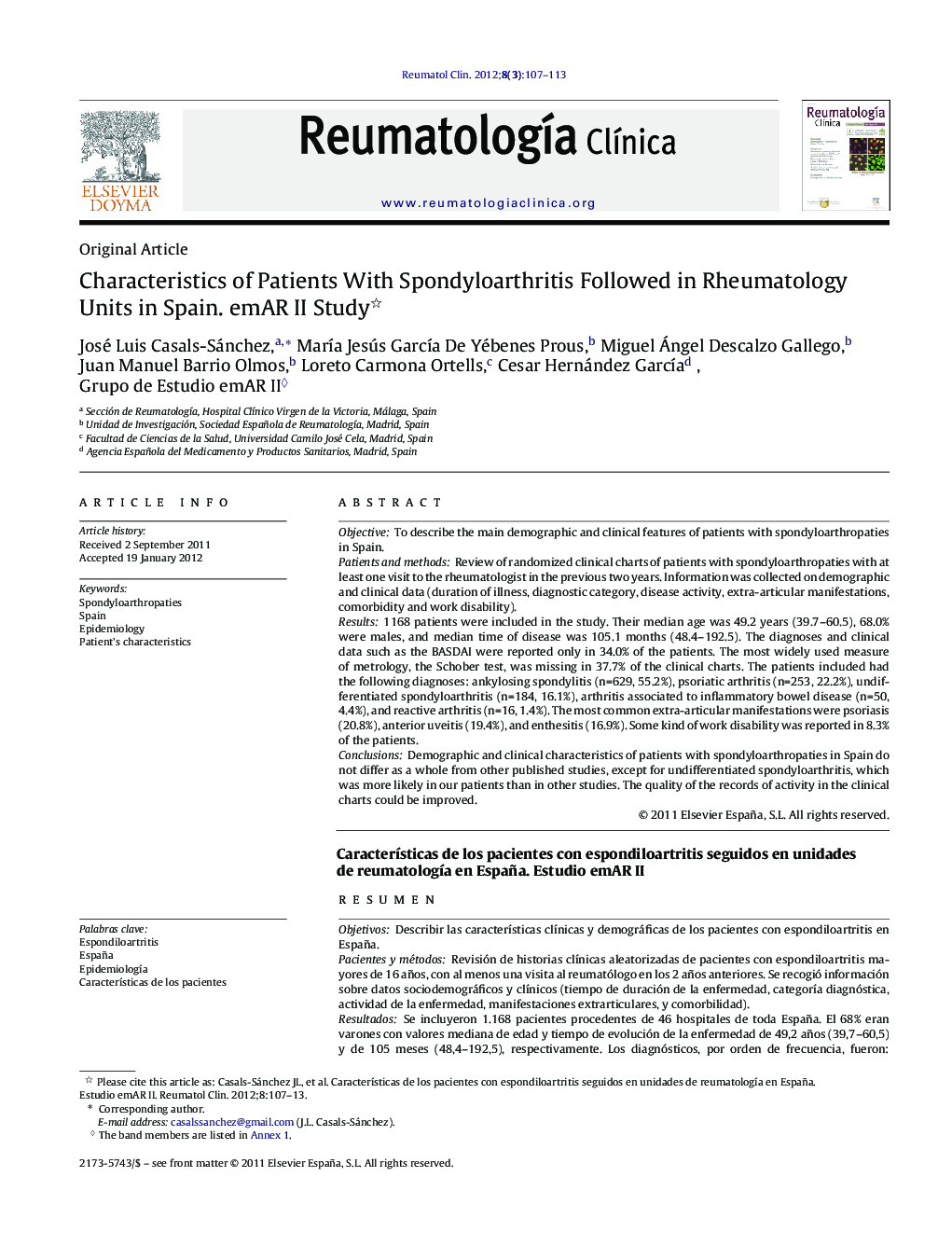| Article ID | Journal | Published Year | Pages | File Type |
|---|---|---|---|---|
| 3384507 | Reumatología Clínica (English Edition) | 2012 | 7 Pages |
ObjectiveTo describe the main demographic and clinical features of patients with spondyloarthropaties in Spain.Patients and methodsReview of randomized clinical charts of patients with spondyloarthropaties with at least one visit to the rheumatologist in the previous two years. Information was collected on demographic and clinical data (duration of illness, diagnostic category, disease activity, extra-articular manifestations, comorbidity and work disability).Results1168 patients were included in the study. Their median age was 49.2 years (39.7–60.5), 68.0% were males, and median time of disease was 105.1 months (48.4–192.5). The diagnoses and clinical data such as the BASDAI were reported only in 34.0% of the patients. The most widely used measure of metrology, the Schober test, was missing in 37.7% of the clinical charts. The patients included had the following diagnoses: ankylosing spondylitis (n=629, 55.2%), psoriatic arthritis (n=253, 22.2%), undifferentiated spondyloarthritis (n=184, 16.1%), arthritis associated to inflammatory bowel disease (n=50, 4.4%), and reactive arthritis (n=16, 1.4%). The most common extra-articular manifestations were psoriasis (20.8%), anterior uveitis (19.4%), and enthesitis (16.9%). Some kind of work disability was reported in 8.3% of the patients.ConclusionsDemographic and clinical characteristics of patients with spondyloarthropaties in Spain do not differ as a whole from other published studies, except for undifferentiated spondyloarthritis, which was more likely in our patients than in other studies. The quality of the records of activity in the clinical charts could be improved.
ResumenObjetivosDescribir las características clínicas y demográficas de los pacientes con espondiloartritis en España.Pacientes y métodosRevisión de historias clínicas aleatorizadas de pacientes con espondiloartritis mayores de 16 años, con al menos una visita al reumatólogo en los 2 años anteriores. Se recogió información sobre datos sociodemográficos y clínicos (tiempo de duración de la enfermedad, categoría diagnóstica, actividad de la enfermedad, manifestaciones extrarticulares, y comorbilidad).ResultadosSe incluyeron 1.168 pacientes procedentes de 46 hospitales de toda España. El 68% eran varones con valores mediana de edad y tiempo de evolución de la enfermedad de 49,2 años (39,7–60,5) y de 105 meses (48,4–192,5), respectivamente. Los diagnósticos, por orden de frecuencia, fueron: espondilitis anquilosante (n = 629, 55,2%), artritis psoriásica (n = 253, 22,2%), espondiloartritis indiferenciada (n = 184, 16,1%), artritis asociada a enfermedad inflamatoria intestinal (n = 50, 4,4%) y artritis reactiva (n = 16, 1,4%). Las manifestaciones extrarticulares más comunes fueron: psoriasis (20,8%), uveítis anterior (19,4%) y entesitis (16,9%). Constaba la existencia de incapacidad laboral en el 8,3% de las historias clínicas. Constaban datos clínicos como el BASDAI solo en el 34% y la medida de metrología más utilizada, el test de Schöber, faltaba en el 37,7% de las historias.ConclusionesLas características sociodemográficas y clínicas de los pacientes con espondiloartritis del estudio emAR II, no difieren de forma global de lo publicado previamente en otros estudios, excepto para el diagnóstico de formas indiferenciadas, que son más frecuentes en nuestros pacientes que en otras publicaciones. La calidad de los registros de actividad en las historias clínicas es mejorable.
